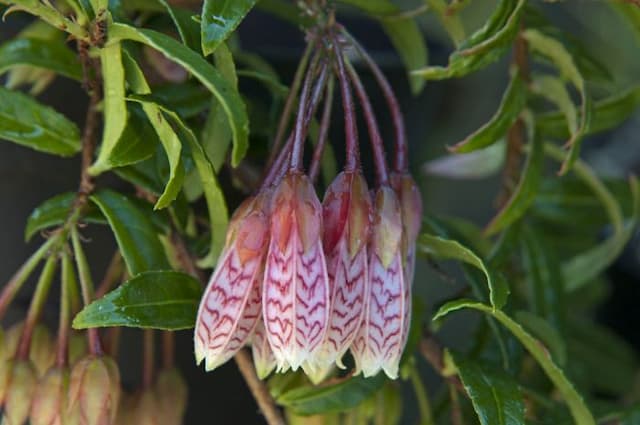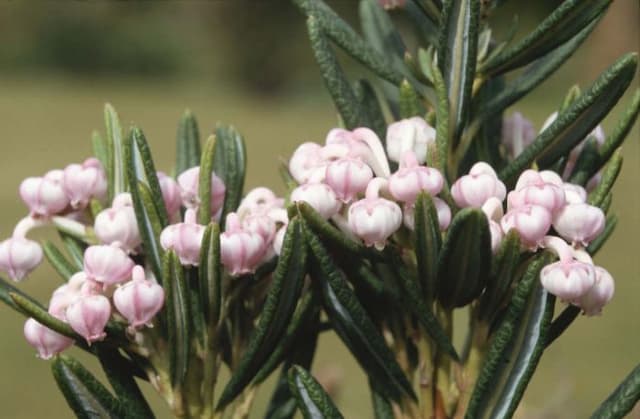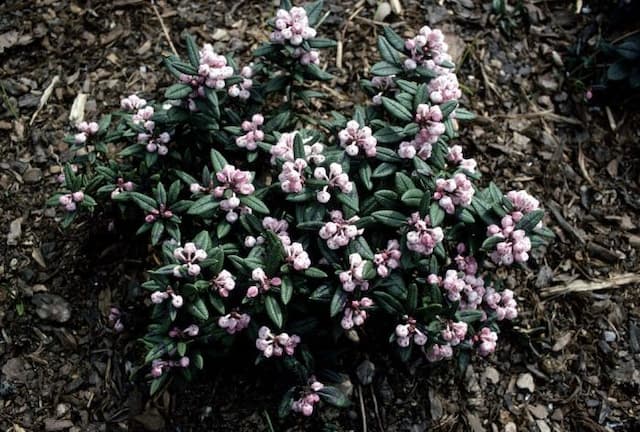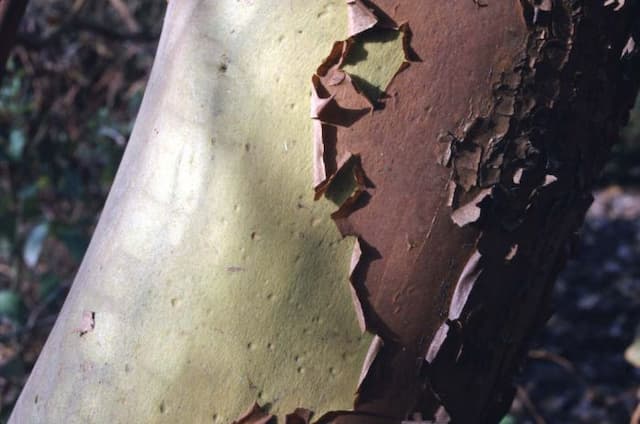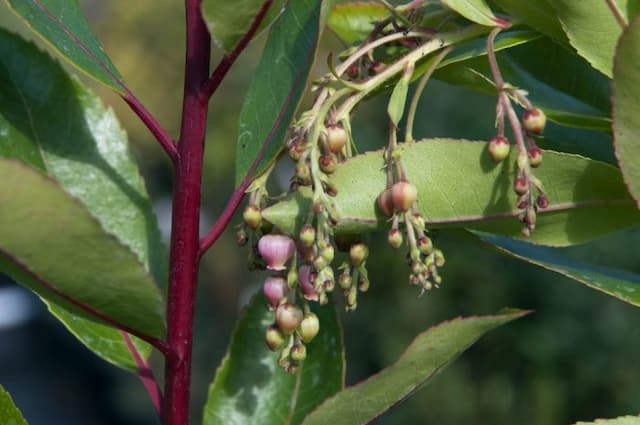Rhododendron Rhododendron 'Addy Wery' (EA)

ABOUT
Rhododendron 'Addy Wery' is a vibrant and visually striking plant, noted for its lush evergreen foliage and the stunning floral display it offers when in bloom. The leaves are dark green, glossy, and leathery, with an elongated oval shape and a smooth edge. They cluster thickly on the branches, creating a dense canopy of greenery. The flowers of the 'Addy Wery' are its most captivating feature. They are large, bell-shaped, and grow in clusters called trusses. The blossoms range in color from a rich red to a deep pink, often with a subtle speckling of darker shades within the throat of the bloom. The trusses create a bold contrast against the dark green leaves, making the floral display all the more impressive. As a rhododendron, this plant conveys a sense of lush, elegant beauty, and the 'Addy Wery' variety, in particular, is much admired for the bright splash of color it provides in landscapes where it is grown.
About this plant
 Names
NamesSynonyms
Addy Wery Rhododendron, Evergreen Azalea.
Common names
Rhododendron 'Addy Wery' (EA)
 Toxicity
ToxicityTo humans
Rhododendron 'Addy Wery' is a cultivar belonging to the Rhododendron genus, commonly known as azaleas. Azaleas contain toxic compounds called grayanotoxins that can affect humans if ingested. Symptoms of azalea poisoning may include vomiting, diarrhea, hypersalivation, weakness, lethargy, loss of appetite, depression, abdominal pain, hypotension, bradycardia, cardiovascular collapse, and potentially coma. The severity of symptoms can vary based on the amount of plant material ingested.
To pets
Azaleas, including the Rhododendron 'Addy Wery', are toxic to pets, specifically cats and dogs. They contain grayanotoxins, which can lead to poisoning when ingested. Symptoms of azalea poisoning in pets can be severe and may include vomiting, diarrhea, drooling, weakness, loss of coordination, lethargy, and in extreme cases, seizures, coma, and death. Immediate veterinary attention is recommended if a pet consumes any part of an azalea plant.
 Characteristics
CharacteristicsLife cycle
Perennials
Foliage type
Evergreen
Color of leaves
Green
Flower color
Mixed
Height
4 feet (1.22 meters)
Spread
4 feet (1.22 meters)
Plant type
Shrub
Hardiness zones
5
Native area
Asia
Benefits
 General Benefits
General Benefits- Ornamental Value: Rhododendrons are known for their spectacular flowers, and 'Addy Wery' provides beautiful blossoms that enhance garden aesthetics.
- Versatility in Landscaping: This rhododendron can be used in a variety of landscaping designs, including as focal points or in mass plantings for a dramatic effect.
- Attracts Pollinators: The flowers provide a food source for pollinators such as bees and butterflies, supporting local ecosystems.
- Seasonal Interest: Rhododendron 'Addy Wery' blooms in spring, offering seasonal interest and color after winter months.
- Evergreen Foliage: As an evergreen, it retains its leaves throughout the year, providing consistent greenery and structure to gardens.
- Durability: Rhododendrons are generally hardy plants that can survive in a range of climates and conditions once established.
- Low Maintenance: Requires relatively low care compared to other ornamental plants, making it suitable for gardeners of all levels.
 Medical Properties
Medical PropertiesThis plant is not used for medical purposes.
 Air-purifying Qualities
Air-purifying QualitiesThis plant is not specifically known for air purifying qualities.
 Other Uses
Other Uses- The Rhododendron 'Addy Wery' can be processed to extract natural dyes for fabric coloring, offering a range of colors depending on the mordant used.
- With its attractive blossoms, Rhododendron can be used in floral arrangements, particularly in large, showy displays.
- The plant is sometimes used for educational purposes, to teach students about plant biology and hybridization techniques.
- Rhododendron wood is hard and dense; it can be used for carving small items such as artistic sculptures or stamps.
- Leaves of the Rhododendron can be used as a natural mulch, providing nutrients to the soil as they decompose.
- Photographers can use the flowers as subjects for botanical photography, leveraging their vibrant colors and shapes.
- Because it's evergreen, Rhododendron can be used as a privacy screen or hedge in landscaping, blocking unwanted views year-round.
- The natural acidity of Rhododendron leaves and flowers can be utilized in compost piles to balance pH levels.
- In regions where it's legal and safe, fallen Rhododendron leaves may be used to create a fragrant, albeit low-burning, fire starter.
- It serves as inspiration for artists and designers, often being depicted in various forms of artwork and pattern designs for textiles.
Interesting Facts
 Feng Shui
Feng ShuiRhododendron is not used in Feng Shui practice.
 Zodiac Sign Compitability
Zodiac Sign CompitabilityRhododendron is not used in astrology practice.
 Plant Symbolism
Plant Symbolism- Beware: Rhododendrons in general are often associated with caution or danger due to the fact that parts of the plant are highly toxic if ingested.
- Elegance and Wealth: Rhododendrons, with their luscious blooms, can symbolize elegance and wealth, akin to the abundance seen in the flowers.
- Homecoming and Hospitality: In some cultures, the rhododendron is a welcoming symbol, representing the desire to return home and the hospitality waiting there.
- Survival and Resilience: Since rhododendrons are hardy plants that can thrive in challenging environments, they also symbolize the ability to endure and sustain through hardships.
 Water
WaterAzaleas should be watered deeply and the soil should be allowed to dry out somewhat before watering again. This typically means watering the azalea once per week with about one inch of water. During dry spells or particularly hot weather, you may need to water more frequently, ensuring the plant receives at least an inch of water each week but spread out over several watering sessions. For container-grown azaleas, it's important to ensure that the pot allows for proper drainage and that you water it until excess water flows from the bottom of the pot.
 Light
LightAzaleas thrive in partial shade, where they receive dappled sunlight or light shade throughout the day. An ideal spot would be under the canopy of deciduous trees or on the north side of a building, receiving bright, indirect light that is filtered to protect the plant from the intense heat of direct midday sun.
 Temperature
TemperatureAzaleas generally prefer a temperate climate with temperatures ranging from 50 to 70 degrees Fahrenheit. They can survive minimum temperatures down to about 20 degrees Fahrenheit but should be protected from frosts and harsh winter winds. The ideal temperature range for azaleas would be between 60 and 70 degrees Fahrenheit.
 Pruning
PruningAzaleas benefit from pruning to shape the plant, encourage bushier growth, and remove dead or damaged branches. The best time to prune azaleas is immediately after they have finished blooming in the spring, as pruning later in the season can remove the buds for the next year's flowers. Prune no more than one third of the branches in a single season to avoid stressing the plant.
 Cleaning
CleaningAs needed
 Soil
SoilRhododendrons, including the 'Addy Wery', thrive in acidic soil with a pH of around 4.5 to 6.0. A well-draining, airy mix is ideal, composed of equal parts peat moss, pine bark, and perlite or coarse sand to ensure good drainage and aeration.
 Repotting
RepottingRhododendrons like 'Addy Wery' typically require repotting every 2 to 3 years or when they outgrow their current container, ensuring that the soil remains fresh and roots have enough space to grow.
 Humidity & Misting
Humidity & MistingRhododendrons, such as 'Addy Wery', prefer high humidity levels, generally between 65% and 80%. In environments with lower humidity, measures should be taken to increase moisture in the air around the plant.
 Suitable locations
Suitable locationsIndoor
Ensure bright, indirect light and good air circulation for 'Addy Wery' rhododendrons.
Outdoor
Plant in partial shade, moist, well-draining, acidic soil for 'Addy Wery'.
Hardiness zone
5-8 USDA
 Life cycle
Life cycleThe life of Rhododendron 'Addy Wery', commonly known as Azalea, begins with seed germination, where warmth and moisture trigger the growth of a new plant. The seedling stage follows, where the first true leaves develop, allowing the plant to photosynthesize and grow. As the azalea matures, it enters the vegetative stage, producing a bushy structure with lush foliage. The flowering stage is marked by the development of distinctive, colorful blooms that are typically seen in spring or early summer, depending on the climate. After pollination, the plant enters the fruiting stage, where seeds develop within capsules, which eventually disperse to begin new life cycles. As a perennial, Rhododendron 'Addy Wery' can undergo multiple flowering cycles over many years, with proper care and favorable conditions.
 Propogation
PropogationPropogation time
Spring-Early Summer
The Rhododendron 'Addy Wery', commonly known as Addy Wery Rhododendron, is usually propagated through semi-hardwood cuttings, a method popular for many rhododendron varieties. This entails taking cuttings from new growth that has started to harden but is not yet mature, typically in late summer. The cutting should be about 4 to 6 inches long, with several leaves left at the top and the remaining leaves removed. The cut end is often treated with rooting hormone to encourage root development and then planted in a mixture of peat and perlite. The cuttings should be kept under high humidity and indirect light until roots develop, which can take several weeks to a few months. This method is favored for preserving the characteristics of the parent plant and ensuring a true-to-type specimen.
